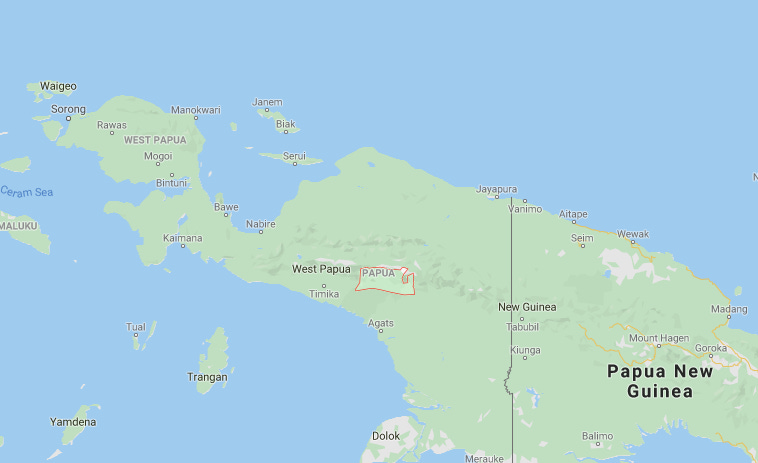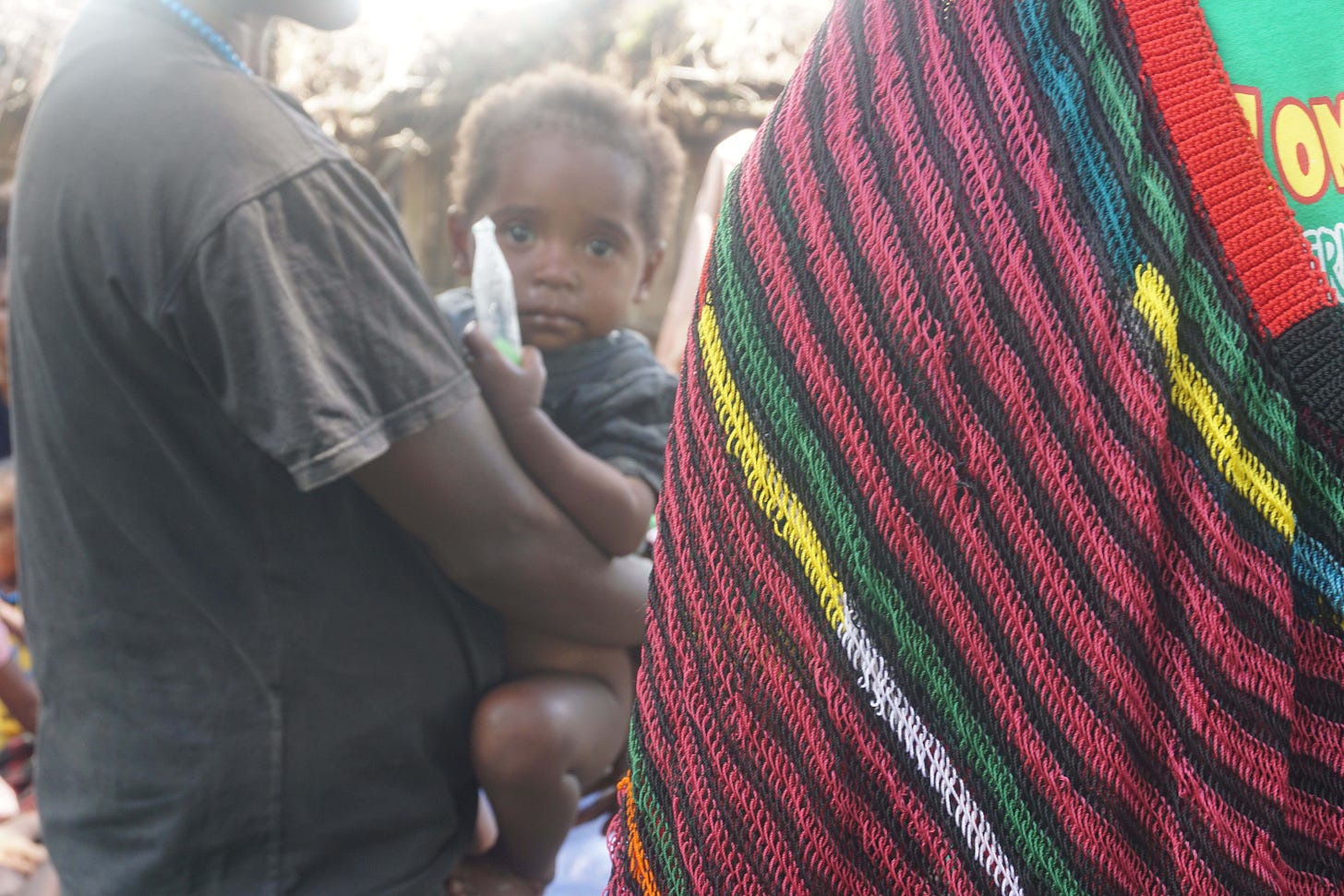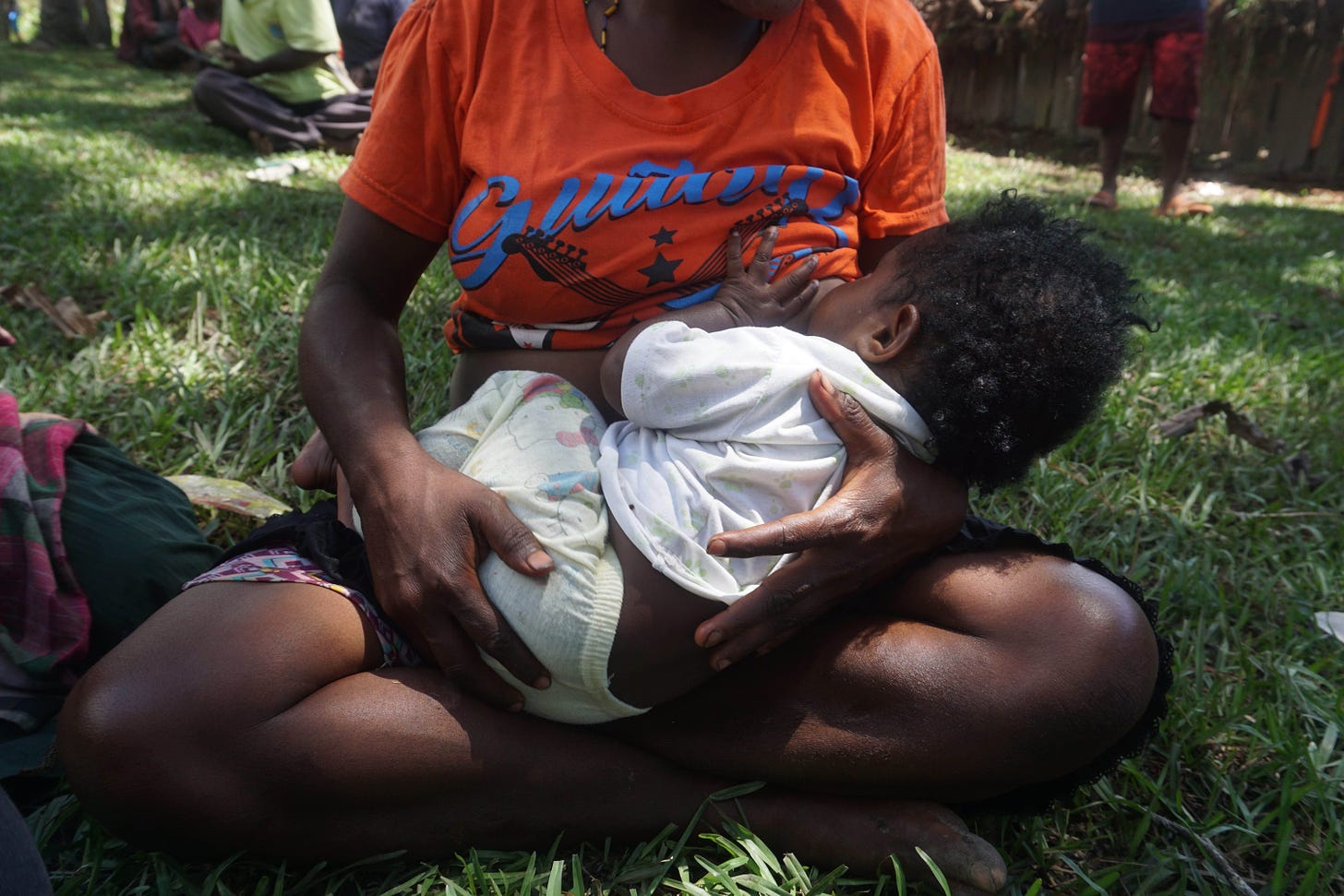Nduga's Internally Displaced Person
Remarks the one year of Nduga's Internally Displaced Person (IDP), we bring you the details of the latest situation from the ground.
Everything about what happened in Nduga is still a blur and close off. It remains an elephant in the room, just like another mass killing case in West Papua during 70s. There has been no case brought to justice. The killing is still happening until today.

Picture: The Ndugas Internally Displaced Children in Wamena are praying for their safety and family, after the volunteers brings doctor to check their health. Photo credit by Febriana Firdaus.
Happy New year to our readers!
We are back with a special edition on Ndugas Internally Displaced Person.
What is Nduga? It’s the name of a regency in the highland of Papua Province. What happened there? Let us explain by showing you a map of where Nduga is located. Here we go (map is attached below).
Since December 2018, Nduga has made headlines in national media after the military attempted to root out Papuan independence fighters who attacked workers of the Trans Papua road construction project (killing at least 17 people). Indonesian military bombed the villages and forced 45.000 Ndugas to flee to the jungle and nearby regencies for safety reasons. Many of them are women and children.

Historical background
A little bit background on Nduga what makes this place so unique, this is the centre of the rebellion. What makes them different? In 1969, we ‘all know that Indonesia took control the Western New Guinea by handpicking only 1,026 people to vote in favour for integration. It is one of the biggest scandal in world history, backed by the United Nations. The event also prompted the Papuan rebels to form West Papua National Liberation Army, which has continued the struggle for independence ever since, including in Nduga.
Nduga, a mountainous area with pristine tropical forests, well-known for its cultural diversity and is part of the World Heritage-listed Lorentz National Park, is inhabited by indigenous Melanesian people who were largely cut off from the outside world until missionaries arrived well into the twentieth century.
They are widely known as the most resistant Papuan across the region against the Indonesian government. The people refuse to admit their region is part of Indonesia and refuse to speak Bahasa Indonesia. Even for other Papuans it is difficult to gain their trust, suspected of ‘work together’ with Indonesian government. Therefore, it’s hard even for the other Papuans to approach them.
Until today, the Indonesian military is still struggling to occupy the region. The challenge for the Indonesian army is to adapt to the weather — the mountain in Nduga is covered by glaciers and it’s freaking cold.
But the Ndugas are used to guerrilla in the mountain. They, traditionally, have followed their elders to join rebels to take revenge on the killing of their parents and family members, and training themselves to survive under the cold weather.
One of the well-known events that mark the history of violence in West Papua, particularly Nduga, is the Mapenduma Operation in 1996. Then, a group of environmental researchers were kidnapped by the rebels. The military rescue operation and its aftermath is shrouded with stories of trauma, when the effort to capture Kelly Kwalik and his group allegedly caused numerous deaths of among the civilian villagers. Last week Tirto published a short article (in Indonesian) about this event.
However, it’s hard to find evidence of anything. Everything about what happened in Nduga is still a blur and close off. It remains an elephant in the room, just like another mass killing case in West Papua during 70s. There has been no case brought to justice.

Back to the IDP
Aside from the difficulties to communicate with Ndugas, fortunately, they still open the door for church. One of the Protestant churches in Baliem Valley has managed to distribute food and clothes to them. Even the emergency school is built just next to the church. But is that enough to help them survive?
We, Voice of Papua’s team, are collecting data from to ground because last December 2019 marks as one year since the Ndugas became refugees. These are important issues of the Nduga IDP that needs to be addressed soon by local and central government.
Two hundred thirty-eight have died. On Dec 10, 2019, we published a special report on the ‘one year of Nduga Internally Displaced Person or IDP’ by interviewing Raga Kogoya, one of the leading volunteers in the highland of Wamena. Raga revealed that “At least 238 (of the IDP) have died, some of them suffered from gun wounds, and some of them were ill,” she said to us. This number is higher than the one released by the Indonesian’s social affair ministry.
Raga added that the number is higher, but some of the Ndugas IDP didn’t report the case to the volunteers. Here are some of the details.
A thousand of student were not able to join national exams. Back when one of our editors visited the Ndugas’ shelter in 2019, there was an emergency school for the children run by churches and volunteers. The school is built from wood and tarpaulin, where students sit on wooden benches beneath a tin roof. During the monsoon season, the class is flooded by rainwater. Even though they can attend the class, but they find it difficult to get access to national exams. Raga said that the volunteers and the teachers are unable or do not have enough legal standings to issue a rapport for them. Therefore, they cannot get any credit for their hard work studying at the emergency school. “The government is very ignorant. They don’t want to open hands and serve these children,” she said. Plus, the local hospital also refuses to serve the children, saying that they only serve Wamena’s residents. Hence, the children among the Nduga IDP lack access to education and health services.
Children join rebels. As many children don’t get enough access to education and health services, some of them prefer to stay in the jungle and even join the rebels. Father Jon Djonga called it as ‘cycle of revenge’. Take a look at the case of the current leader of the West Papua Liberation Army-Free Papua Movement in Nduga, Egianus Kogoya. He is apparently the youngest son of the group's former leader Silas Kogoya who was killed during the Mapenduma Operation. Last Saturday (January 11), one police officer was shot and injured when Kogoya group attacked a security post at Kenyam Airport. The police are now on the hunt; it seems this is far from over.
A trauma healing centre is urgently needed. The Indonesian government, via social affair ministry, have not yet provided any trauma healing therapy to the Nduga Children’s IDP. The volunteer has requested the treatment since the first wave of Nduga IDP flooded Wamena in 2018. Children in Nduga are still traumatised from the incident, as some of them witnessed how the military bombed their village, their friends and siblings shot to death and starving while fleeing to the forest. The volunteer said to us, if only the government provide the trauma healing therapy, perhaps we can cut the ‘cycle of revenge’ and prevent the children from joining the rebel army.
The killing is still happening. Residents and human rights activists found a total of five bodies, suspected to be victims of shootings by unscrupulous members of the Indonesian Military in Iniye village, Mbua District, on Thursday, Oct 10, 2019. The five bodies were three women and two young men. They were found in a hole covered with leaves before being buried in the ground. The family of Samuel Tabuni, one of the Nduga youth leaders who died, explained that on Sept 20, 2019, the victim brought food from Wamena using a Strada type of car to Nduga via the Papua Trans road. He was allegedly shot by the Indonesian military. Another case is a driver name Hendrik Lobere in Nduga was shot to death by Indonesian military, and prompted the Nduga’s vice regent Wentius Nimiangge to resign as a sign of the protest. The Security Minister Mahfud MD denied the accusation that it was the military forces who killed the driver, however, a fact-finding team has been formed to investigate the case.
In any case, the Nduga’s IDP have been living in 23 shelters in Wamena city, Jayawijaya, regency without decent toilet and proper bed. The latest, we published story about (finally) the plan of the Regent of Jayawijaya to invite his Nduga counterpart and its officials to talk about the IDP. One of the crucial topic of discussion will be the allocation of budget for the IDP which reached Rp 75 billions. The question is where did the money go?

What we read?
Indonesian army wields internet 'news' as a weapon in Papua. Reuters investigated the Indonesian military funds ten websites, some of which have been operating since mid-2017, that uniformly published positive coverage of government, military and police alongside articles that demonize government critics and human rights investigators. The subjects of some stories told Reuters the websites attributed invented quotes to them and published other falsehoods.
Sarawak's Logging Tycoons in Papua New Guinea. Over the past 50 years it has been commonplace for certain leaders, particularly in East Malaysia, to criticise past colonial ills whilst at the same time embarking on their own unprecedented rampage of resource grabbing, first within their own borders and then throughout the region. The consequences have been described by its many victims in Papua New Guinea as “worse than colonialism” to Sarawak Report – a sentiment echoed by so many of the native peoples of Sarawak whose lands were snatched by outside interests aided and abetted by corrupt local leaders. Read the Sarawak Reports latest investigation on Malaysian logging and plantation records in Papua New Guinea.
That’s a wrap for this newsletter. We’ll be back two weeks from now!
Help us get the word out. Tell your friends to sign up for short but unmissable updates.

